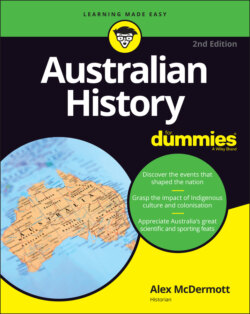Читать книгу Australian History For Dummies - Alex McDermott - Страница 33
Settling in early
ОглавлениеDuring the Ice Age, sea levels were much lower than today (all that ice had to come from somewhere, after all). One advantage of this was that it was a lot easier to walk to new places, as distinct from swimming or sailing. Australia and New Guinea were connected by a giant land bridge, which explains why these now-distant countries have so many plant and animal species in common. Nevertheless, it was still a long way over open water for prehistoric humans to get to Australia, so whatever else we may conjecture about the first settlers, we’re certain they knew their way around a boat.
No-one knows exactly when the First Australians arrived. The evidence is scanty and, at times, contradictory. Even genetic research is unable to resolve whether Aboriginal people came in one big push or many successive waves. Like all humans, they originated in ancient Africa, but after that, their lineage is still quite murky.
Recent genome sequencing, for example, seems to indicate the one big push theory is correct. However, DNA testing of Aboriginal remains (estimated to be around 40,000 years old) found at Lake Mungo revealed they didn’t share ancestry with modern human beings. Some scientists have speculated that this means migration to Australia didn’t occur in one wave.
Aboriginal tribes of Australia / by Norman B. Tindale, Mitchell Library, State Library of New South Wales, M3 804eca/1788/1.
FIGURE 2-1: Aboriginal Australia pre–European settlement.
According to the genome research from 2016, Papuan and Aboriginal ancestors reached the supercontinent that included what would become Australia around 50,000 years ago, picking up the DNA of Neanderthals, Denisovans and another extinct hominin along the way. The same study indicated Papuans and Aboriginals then split around 37,000 years ago, long before the continents were finally cut off from each other around 8,000 years ago. Although they must have passed through South-East Asia on their way to Australia, they aren’t related to any known Asian population. Today, linguistic similarities exist between some Aboriginal people and the indigenous peoples of New Guinea, but this is likely to be the result of (relatively) recent trade and intermarriage.
Who these first settlers were, where they came from, and why they came to Australia may always remain a mystery. All we know is, when the glaciers melted and the sea levels rose again, Aboriginal people abandoned boating and stayed where they were.
In Tasmania, the people became further isolated when the land bridge to the mainland vanished under the rising water. It’s a vivid image: Picture a populated fertile promontory with a thriving trade across a slowly eroding isthmus. One day, it’s a short swim to the local hunting ground, then a few years down the track it’s crossable by canoe … until, finally, the mainland recedes from sight, memories fade, and the Tasmanians are on their own for the next 12,000 years.
Exactly how long it took for Aboriginals to spread out over the continent is disputed (as is just about everything in this very remote period). Anywhere from a few thousand to over 10,000 years has been suggested. What isn’t disputed is that, despite the immense diversity of the continent (desert in the centre, tropical rainforest on the Cape, glaciers on the mountains of Tasmania), Aboriginal peoples found ways to thrive in every ecological niche available.
